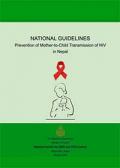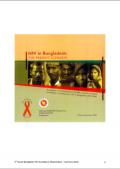What's New
Displaying results 4641 - 4650 of 4914

Resource | Publications,
The writers conducted several of site visits in Port Moresby, Lae, Mount Hagen and Rabaul including meeting, training and workshop. For a better caring, monitoring and evaluation of HIV/AIDS cases in the country, national guidelines for adult, children and pregnant women were developed together with the recording form and procurement system. The surveillance and post exposure prophylaxis reporting form and guidelines were revised and developed. The referral system was developed to strengthen HIV/AIDS care and increase drug adherence. The training for comprehensive HIV/AIDS care were set and given to the medical staffs in PMGH, 3 regional hospitals and NGOs.

Resource | Publications,
Given that the spread of HIV throughout a community or a country is entirely contingent on human behaviour, we must acknowledge that public health interventions designed to prevent HIV transmission need to take account of the sexual practices of the relevant population. A more comprehensive approach would also consider other behaviours related to the spread of HIV - for example, behaviours around intravenous drug use and blood transfusions. The patterns of human sexuality within a population are generally considered to be culturally specific; as such, we need to evaluate societies individually if we wish to introduce public health measures for sexually transmitted infections (STI) that have both local relevance and local acceptance.
The Burnet Institute undertook a study of the sexual behaviour of young men in Vientiane from August to November in 2004. The study was funded by the Royal Netherlands Embassy in Bangkok.

Resource | Publications,
Since the first report of HIV infection in India in 1986, the virus has spread all over the country although there is geographic variation. There are estimated 5.1 million people infected with HIV with an overall estimated adult prevalence below 1 per cent. Surveys carried out in different sub-populations have yielded prevalence estimates, but data on HIV incidence are limited. Both HIV serotypes 1 and 2 exist in India and HIV-1 C is the commonest subtype reported. Sexual transmission of HIV is most predominant. Spread of HIV in intravenous drug use settings is localized mostly in the north eastern region and metropolitan cities and parent to child transmission is on the rise. Dual epidemics of HIV and tuberculosis, increase in the number of infected women, stigma and discrimination are the main concerns in the Indian HIV/AIDS scenario.
There is an increasing political will and commitment for HIV prevention and control efforts in India. A multi-disciplinary approach combining targeted interventions like early identification and treatment of STDs, condom promotion, blood safety, drug de-addiction programs and expanding and strengthening VCTCs and long-term strategies like awareness oriented to behavioural change especially among vulnerable populations, young people and women, steps towards improvement of literacy, status of women and overall development, reduction in poverty and development of primary prevention interventions like vaccines and microbicides will have to be considered for effective prevention and control of AIDS in India.

Resource | Publications,
The purpose of this document is to provide guidance to decision-makers in the development of PMTCT interventions in clinical settings, as well as to provide users with the correct technical information on MTCT and PMTCT.
Mother-to-child transmission is by far the largest source of HIV infection in children in Nepal. Out of estimated 900,000 annual pregnancies, 1,800 pregnancies are estimated to occur in HIV positive women leading to an annual cohort of about 450-810 infected newborns.

Resource | Publications,
In Malaysia illicit drug use was considered a menacing concern and an enemy of the people. The government has implemented various strategies to tackle drug use with the current goal of achieving a drug free society by 2015. Yet, even with increasing draconian punishments imposed for drug use there was a substantial rise in both new and relapse drug user cases. Of increasing concern was the unresolved HIV infected notifications, mainly found among injecting drug users (IDUs), but also of a potential generalized HIV epidemic occurring within the coming years. This situation assessment of Malaysia, examining drug issues from a public health and public security perspective, shows the complexity, challenges and responses of drug use and HIV/AIDS. This report has been produced on behalf of the Infectious Diseases Unit, University of Malaya Medical Centre, with assistance of the Burnet Institute, The Centre for Harm Reduction.

Resource | Publications,
World AIDS Day is commemorated around the globe on 1 December. Along with other countries of the world, Bangladesh also observed the Day by re-affirming its promise to confront the AIDS epidemic.

Resource | Publications,
Bangladesh is a low prevalence nation for HIV, and therefore, according to the guidelines of the Second Generation Surveillance system for HIV, surveillance should concentrate amongst selected groups of individuals who are known to be most at risk to HIV and some of the population groups that may bridge the epidemic into the general population. Therefore during all rounds of surveillance conducted so far in Bangladesh, including the fifth round, the population groups selected were confined to those considered to be most vulnerable and some bridging populations.

Resource | Publications,
The objective of the current BSS (Wave II) was to provide trends of behavioral indicators to inform program development for the expansion of interventions aimed at the reduction in the transmission of HIV/AIDS and Sexually Transmitted Infections (STIs) in the selected districts of Maharashtra.

Resource | Publications,
The National Youth Risk Behaviour Survey 2003- 2004 was conducted by the Ministry of Education, Youth and Sports with the support of UNICEF and UNESCO. The aim was to assess the risk behaviour of young people between the ages of 11 and 18. In addition to basic personal and family data, the survey covers risk activities divided into ten areas of sexual behavior; sexually-transmitted diseases and HIV/AIDS; weapons and violence; alcohol; smoking; drugs; traffic safety; food and health; worry, depression and suicide; and exercise and sports.

Resource | Publications,
HIV/AIDS spending in Thailand was 4,943.32 millions baht (122.90 million USD) in 2004, nearly doubled from that of 2,623.27 millions baht (65.4 million USD) in 2000. HIV/AIDS spending per capita increased from 1.05 USD in 2000 to 1.91 USD in 2004 while expenditure per capita PLWA increased dramatically 2.3 times from 94.19 USD in 2000 to 214.68 USD in 2004. In addition, the share of HIV/AIDS expenditure to total health expenditure (THE) increased from 1.57% in 2000 to 2.64% in 2004.
There is a need to establish an integrated information system for the efficient management of HIV/AIDS resources. NASA is useful tool to inform policy decision on effective allocation of limited resources. It provides information on amount of resource used and pattern of spending. NASA reports resource availability, when matching with resource need forecast, a financial gap is estimated. Resources gap is important information for resource mobilization and efficiency improvement.





